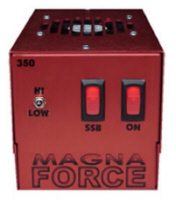Things to know before you buy an amplifier for CB Radio

If you’re asking the question “Should I buy an amplifier?” then you’ve probably decided you need more power output, or someone you know has told you to buy one. Before we get into a discussion on buying an amplifier, first let’s pose another question. Do you actually need an amplifier?
A standard CB radio is going to have an AM carrier (also know as deadkey) of around 3 to 4 watts. Once the carrier is modulated, output on the radio may reach 10-12 watts on average with some models hitting around 15-18 watts. Single Sideband models (SSB) will normally have output of 12 watts, with some models hitting around 18-20 watts after tuning. These output numbers are more than enough for basic local in-town communications if an operator has properly set up their antenna.
Once you’ve been in the hobby long enough you’ll hear many stories of people saying their signal doesn’t go very far, so they purchase high power radios or amplifiers not realizing that the problem from the very beginning was a poor antenna setup. Ham radio operators love to tell stories of using 1 watt on a dipole antenna to talk to a station 9000 miles away, but what they are saying is really the truth. It’s absolutely possible to talk long distances and even talk pretty far locally with a legal radio and a good antenna.
So before you consider adding an amplifier you should sit down and think about some answers to the following questions….I know this sounds like going back to school, but it can save you a lot of money and trouble in the long run.
1) Do you mind breaking the law?
Okay, so some of the more seasoned CBer’s might laugh at seeing this question but I wouldn’t be doing my due diligence if I didn’t mention this from the very start. Using an amplifier with your CB radio is illegal and you can be fined and even be given jail time by the Federal Communications Commission (FCC). Scary right? While the FCC and most ham radio operators will frown upon your purchase and use of an amplifier, it’s a simple fact that there are thousands of people in the United States (and in other countries where it’s illegal) running CB amplifiers and none of them have ever had an issue with the FCC. If you don’t believe in speeding, you probably shouldn’t use an amplifier, but for a large part of the CB community amplifiers are just another tool they use everyday.
If you use your amplifier wisely you most likely could be on the radio for 100 years and never have an issue with the FCC, but if you plan to be an idiot and play music through your 1000 watt amplifier you might just get a visit from the man.
So while adding an amplifier won’t put you on America’s Most Wanted it’s best to be smart in how you operate and try not to cause problems for yourself or others. If you are still fuzzy on the legality you might read through my article Legal Mumbo Jumbo, or better yet read through the FCC rules on amplifiers.
Still want to add an amplifier? Okay…read on at your own risk.
2) Have you optimized your current setup?
This is the starting point for most CBer’s and if you’re reading this article I’m guessing you want an amplifier because you want to talk further. More power = more distance right? While this is definitely true you can also achieve more distance with a properly tuned radio and antenna system. If you currently have a wilson 3 ft fiberglass antenna on the bumper of your truck, you might easily gain a 30% improvement in performance and distance by moving to a longer antenna such as a Wilson 1000 or Wilson 5000 mounted in the center of the roof of your vehicle. Adding an amplifier might also give you a boost of 30% or more with your current system but what’s the point of adding nitro to a station wagon? Get your current system set up correctly and if you still want to talk further…add the amplifier.
3) Is your current system capable of handling more wattage?
There are many people who run out and buy an amplifier without realizing that there is a lot to learn before setting one up for the first time. One very important thing to know is that antennas have maximum wattage ratings; for example, a K30 magnetic antenna has a manufacturer rating of 300 watts. Now here’s a little hint you need to know – manufacturer ratings are generally pretty overstated. In this case the K30 probably is actually rated for 150 watts and even then I wouldn’t recommend running that much power into that antenna. Seriously, I’d only run about 75 watts into that antenna. What does this mean for your system? It means if your antenna is currently rated for 500 watts and you just bought a 6 transistor amplifier with an output rating of 600 watts, it would not be a good idea to use your current antenna.
Beyond the wattage ratings of your antenna you also need to consider that amplifiers draw a lot of electricity to produce their output. If your car only has a 90 amp alternator and your 6 pill amplifier is going to draw 100 amps, you will quickly realize you bit off more than you can chew.
Last thing to consider is your current radio. Amplifiers usually don’t like to be overdriven (too much input from your radio). If your current radio isn’t setup to run with an amplifier you can easily ruin your $400 amplifier.
In this amplifier series we will cover all the basics so hopefully all of these scenarios can be avoided, but you absolutely need to analyze your current system before adding an amplifier.
4) How much power do you need?
When trying to figure out how much power you need it’s best to analyze your goals.
If you and another friend go out 4×4’ing and you tend to find that you have trouble hearing each other over the next hill, then a simple 100 watts might be enough to solve your situation. If you like to talk DX (skip) on 38 LSB and you have trouble making contacts on busy days, again 100 watts might be all you need. In fact I’m going to let you in on another little secret….100 watts is what I like to call the magic number. For most people it really is enough power to help you talk a little further without having to spend a whole lot of money or make major upgrades to your system.
There is also a certain formula to how much wattage = a louder station and when the equation is graphed out a lot of people are surprised by how it works. One of the best things you can do before buying an amplifier is to have a look at a graph created by X-11 in the article Power in Perspective. It offers a simple and practical look at power and distance.
5) Do you plan to talk on AM, SSB, or both?
AM and SSB modes can require different features on an amplifier. For instance a SSB amplifier will need a delay while an amplifier for AM does not. If you have a straight 40 channel AM-only radio then you can pretty much purchase any of the CB amplifiers on the market; however if you intend to use your amplifier for SSB you’ll need to look at a couple of other things, such as the aforementioned delay and also the amplifier class. Most AM CB amplifiers tend to be a little “dirty” in terms of their output signal, meaning that there are certain levels of distortion, harmonics, and other unwanted effects. While these are certainly problems (and usually found on class “C” amplifiers) for the AM crowd many of the effects will go unnoticed and aren’t a huge concern to those operators. On SSB, however, a “dirty” amplifier can effect how you sound enough that as you use it on the air people may comment negatively about your station, so it’s best to buy the right amplifier for the job.
On the topic of AM vs SSB, there is again the issue of input and overdriving your amplifier. SSB transmissions don’t have a carrier, so in most cases your radio doesn’t need any special modifications to transmit on SSB with an amplifier. On AM, however, if your radio has a carrier of 4 watts and the amplifier has input requirements of 2 watts you’ll need to lower your radio’s carrier. Lowering the carrier of a radio might mean opening up the radio and adjusting a potentiometer on the board, or it might require more drastic modifications using capacitors and resistors, something you might want a CB shop to do.
So again these are questions that need to be answered before shelling out dough for a shiny new amplifier.
Once you’ve figured out if your current system is ready for an amplifier and how much power you’d like to run, then the next step is picking the right amplifier for your purposes.
